 |
 |
| home | recipes | about paprika | photos | links | history | shopping | learn hungarian | contact |
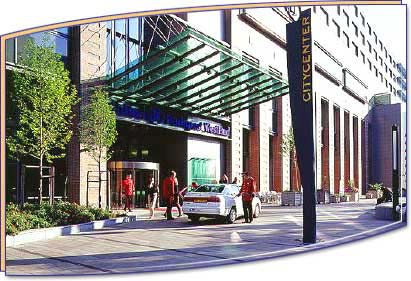
Gone (mostly) are the communist-style shops with a less than minimal selection of merchandise and less than interested salespersons. On my first visit to Hungary in 1993, barely four years after the fall of the old regime, shopping was quite a disappointment. While the touristy shops on fashionable Vaci St. offered porcelain, crystal, linens, and typical souvenir items, mainstream housewares, clothing, and electronics were almost impossible to find at almost any price. Even groceries, while plentiful, were limited to very standard items. I remember a “major” department store in Tapolca near the Balaton in which I saw only three or four models of refrigerators (very expensive by our standards), a few overpriced housewares, and some really ugly shoes. Hungarians, who could afford it, crossed the border into Austria to shop and returned with their treasures, hoping the border guards would not confiscate them.Bit by bit, however, the face of Budapest was changing—the city was rebuilding, cleaning and restoring crumbling architecture, maintaining parks and boulevards, and the city’s infrastructure began to focus on promoting commerce.
Today, the shopping scene is very different. One of the first large stores I remember seeing back in 1995 is the Metro, a membership warehouse store very similar to our stores such as Costco. Metro revolutionized shopping in Hungary by providing an extensive grocery section as well as appliances, clothing, housewares, and electronics at more reasonable prices. The Metro chain has grown, and you will find their stores all over Hungary. 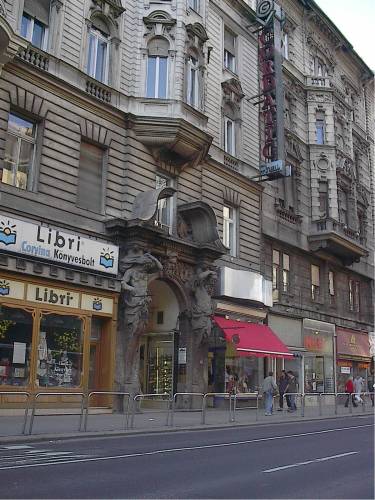
The modern shopping mall concept also began to emerge. In Budapest, the trendiest mall is the Western City Center next to the Nyugati (Western) Railway Center. Its architecture could easily fit into any modern U.S. city and its shops offer a wide array of very acceptable goods. The anchor store is MediaMarket, a huge store offering everything we would find in a typical computer/electronics store. Duna Plaza, another modern center, is host to Keravill, another large electronics, housewares, and appliances chain, among many other smaller retail shops. The Arkad Center next to the newly remodeled IKEA is another large center. Although traffic is usually snarled on the major streets, the distance between any two centers is not very great. On the Buda side, the modern Mammut Center has expanded and also offers many retail shops.
The population, largely budget-conscious by necessity, has embraced the do-it-yourself stores which include Obie, Brico, and Praktiker. These are like Home Depot both in appearance and in their merchandise, although the mix of products they offer is sometimes strange. These stores do provide Hungarians the opportunity to upgrade and remodel at reasonable costs—and from all appearances, they are doing so in record numbers.
Another genre of stores called Hipermarkets recently came onto the scene providing one stop shopping in stores such as Tesco, Cora, and the newest among them, Auchan. At one of these stores, I noticed 70 checkstands! These are also located within a shopping mall environment with large parking lots. These stores are truly immense, larger in square footage than anything I can relate to in the U.S., at least in California. The Auchan in Dunakeszi boasts 20,000 square meters (not feet!!) of sales area with again about 70 or 80 checkstands. About half the floor space is devoted to groceries, the other half to household goods. I noticed that some of the employees moved around the large area on roller blades! These stores offer some of the lowest prices available, and fairly good quality merchandise making their items available for the first time to mainstream Hungarians. Naturally, these larger stores are not without controversy due to the competition with smaller, family-owned retail stores. Interestingly enough, the smaller specialty stores are still around and surviving in this competitive environment. Apparently, many people still prefer shopping in more personal stores. 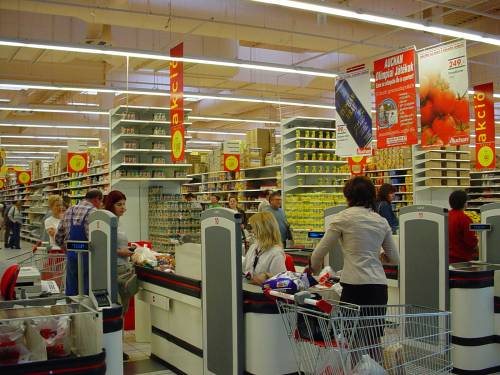
I found that while the new hipermarket stores provided much variety, the vast shopping area required about 2 to 2 ˝ hours minimum to do the weekly grocery shopping. Surprisingly, the lines are seldom very long and move quickly. Baggers are not considered a necessity, so you largely bag your own purchases. The checkers are seated at their stands and selectively bag some items for you (I never understood the system). If your purchase includes an electronic item or appliance, you must take it to customer service to receive a validated warranty. These lines do jam up frequently. I once decided to forego the warranty on a small appliance because we had checked out at the first checkstand, and the Customer Service desk was well past the last checkstand which looked to be a quarter-mile away! Be sure to note where you park! The parking areas are very large and once at a huge Cora center, we couldn’t find our car—a very common make, model, and color of which there are thousands upon thousands in Hungary.
Customer service is a newer concept in Hungary—very different from the old days, and you will experience much pleasant attention as a customer. However, the notion of returning an item you purchased has a ways to go. Typically, there is a three-day limit to returning an item, and even then you will not receive a refund. You may need to use the credit from the item that same day or lose it.
I really tested the system when I attempted to return a dining table to Kika, a large department store. Returning furniture was really unheard of and the store was dumfounded with my request. I had had the table for three weeks, but just did not like it and I wanted to exchange it for a larger one of the same type. The department sales associate was very friendly and polite, but said this would probably not be possible. Finally, after a long discussion about how terribly inadequate the table was and agreeing to a 10% restocking fee, I was told I could return the table. Not wanting to lose the opportunity, we promptly took it back the next day. I was greeted with the news that the restocking fee would now be 20%. After talking with another person, the fee was reduced back to the original 10%, but completing the paperwork and finalizing the credit took almost two hours! Kika is, however, very nice store and surely this was a very unusual transaction for them. Kika has very good quality furniture and housewares at reasonable prices. Another large store is Domus, featuring more furniture than housewares, but it does have some linens and rugs.
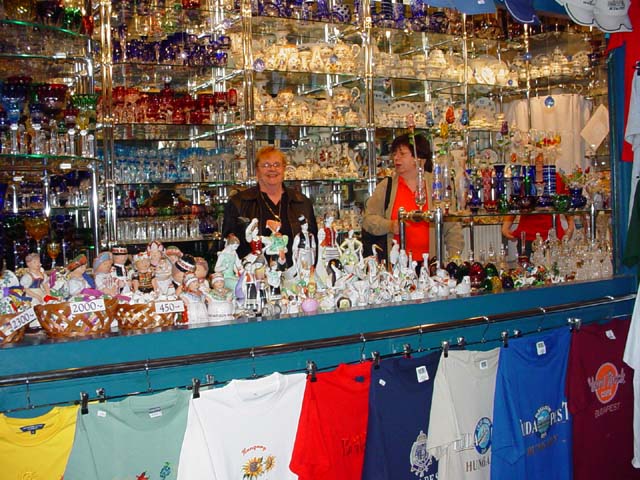
Shopping in Budapest is not complete without going to the large Market Hall or Nagy Csarnok! The Market Hall comprises three levels, with the main level largely food items—salami, sausage, cheese, fresh meats and vegetables attractively displayed. The upper level is for souvenir shopping—linens, pottery, porcelain and the typical souvenir items. The linens are good quality although some may be overly decorated, but you can find many beautiful items and prices to match. This is not a discount store by any means, however, these vendors are reliable and the products are decent.This is truly the place to stop for a snack of langos, a large fried bread puff served with garlic melted butter, sour cream and shredded cheese. This must be accompanied with a beer! This puff is laden with calories, but very delicious calories, and will keep you full for hours. The place offers only stand up eating at counters on the side, and napkins are rough paper towels, but if you have some tissue in your purse, you can clean off the butter from your fingers and without any trouble. These langos are well worth the mess!
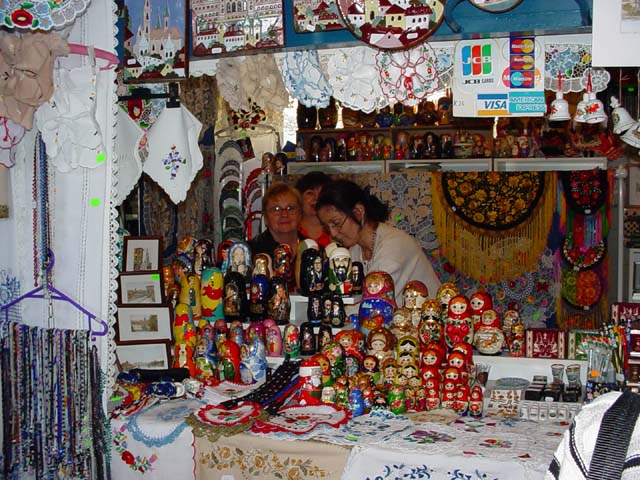
See also Talking Cities for more information on shopping in Budapest.
|
|